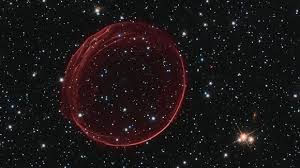THE HARTLE HAWKING STATE AND THE CREATION OF THE UNIVERSE
- planck
- Aug 27
- 10 min read
Our standard cosmological model includes a very brief period of exponential expansion called cosmic inflation, which ended with the Big Bang. To understand what could have happened at the very moment of the Universe's creation, we must study what happened at the very beginning of this inflationary period. At first glance, this task seems beyond the reach of science and therefore inaccessible to human knowledge. However, theoretical physicists, armed with the most powerful tool in existence (mathematics), are capable of achieving truly incredible things. In this article, we will study in detail how two physicists achieved the incredible feat of proposing a feasible and testable model for the quantum creation of our Universe. To this day, this model remains one of the most interesting and convincing proposals to explain the origin of our Universe. Welcome to the very moment of the creation of everything that exists!
The double-slit experiment and Feynman path sum
Before attempting to explain how the (quantum) creation of our Universe could have occurred, we must start with the most basic: quantum mechanics. Three different but equivalent formulations of quantum mechanics theory can be highlighted: Heisenberg's matrix formulation, the "standard" wave formulation developed by Schrödinger, and Feynman's path-integral formulation. In this section, we will focus on the latter.
Consider the famous double-slit experiment:

The probability that the screen registers the electron when only slit 1 is open is P1 while the probability when only slit 2 is open is P2. Classically we would expect to find that the total probability P is the sum of both probabilities P=P1+P2 but what we actually find is:

Where Psi 1 and Psi 2 are two complex functions, that is, functions with a real part and an imaginary part, or equivalently, functions with a magnitude and an argument. The final probability is the sum of the magnitudes (amplitudes) of these complex functions. The value of an individual amplitude can be written as:

Where S is the value of the action. Therefore, in the two-slit experiment, to calculate the correct probability, we must evaluate two different paths with actions S1 and S2:

Next, we ask ourselves, what happens if we open more slits? If we open n slits, the probabilities will be:

That is, the total probability is calculated by considering all possible paths (slits) between the source and the screen . Finally, we can consider the most general case: that of the propagation of a free particle. In this case, we consider the fact that the screen can be located at any distance, and we can imagine an entire array of screens located at many possible distances with many infinitesimal slits. In this case, we find that the probability is:

Where x refers to the position of the particle. This is the famous Feynman path integral and it expresses the insight of quantum mechanics that Feynman discovered: the probability of a particle propagating from point A to point B in a certain time interval is equal to the sum of the amplitudes associated with all the possible paths between A and B. If we consider macroscopic distances, the action is much larger than hy and the exponential varies very rapidly, causing nearby paths to interfere destructively and cancel each other out. In this way, only the classical trajectory survives: the trajectory where the variation of the action is zero (thus fulfilling the Universal principle of least action). As we will see, this expression hides something very profound about the very nature of space-time.
The gravitational path integral
If we want to study the beginning of the Universe, we must incorporate gravity into our previous path integral. Since gravity is actually the motion of space-time itself, the way to achieve this is to consider each possible path as an individual and independent space-time. That is, each possible path between A and B would correspond to its own space-time, such that the function we are evaluating is a quantum superposition of all of them. In this way, the total wavefunction would behave as a wavefunction of all possible paths. Close paths interfere destructively and cancel each other out, such that, at large distances, only the classical trajectory survives. The expression that represents this superposition of space-times is called the gravitational path integral and is the most commonly used tool in all approximations of quantum gravity:

This expression means that to calculate the probability of transition from a space-time with metric gmv at an instant A to another with the same metric at instant B we must add up all the possible space-times or "paths" between A and B. Due to the factor S/h this sum is a weighted sum, that is, some paths have a higher probability than others.

Left: To calculate the probability that a particle located in A at time t=0 propagates to B at time t=1, we must consider all possible paths between A and B. Right: To calculate the probability that a spacetime with metric hij at time t=0 evolves to a geometry with the same metric at time t=1, we must consider all possible spacetimes between t=0 and t=1.
The Hartle-Hawking State and the Creation of the Universe
Physicists James Hartle and Stephen Hawking decided to apply the gravitational path integral to our Universe as a whole. "Point A" of the integral would be the initial instant of the Universe with a three-dimensional volume tending to zero, "point B" would be a Universe like the one we observe today: an acceleratingly expanding space-time. Cosmological observations tell us that our Universe began in a highly homogeneous and isotropic state, and we know that we are currently in a state of slow, accelerating expansion (space-time).
De-Sitter), therefore, we have to include in the integral all spacetimes that start in the simplest possible state and end in a spacetime type
De-Sitter. The problem now is: What initial conditions should we consider in the integral?
The simplest possible state is the vacuum state (state of minimum energy). In quantum field theory, the vacuum state is usually specified by a Euclidean integral. In a Euclidean integral, we make the change of variable t=it such that the Lorentzian metric S2 = (x1) 2+ (x2) 2+ (x3) 2- t2 becomes S2 = (x1) 2+ (x2) 2+ (x3) 2+ t2 and all components of the metric are positive (Euclidean metric). Hartle and Hawking realized that if they used a Euclidean spacetime instead of the Lorentzian metric, they solved the problem of the initial conditions: the initial singularity disappears and with it the edges or boundaries of the origin of the Universe disappear . In this way, it is not necessary to specify the initial conditions! In Euclidean space-time, both space and time can take complex values and behave identically. This can be represented, for example, as follows:

Image taken from this article . In Euclidean space-time, both space and time have spherical geometry and therefore have no edges or boundaries.
The most striking consequence of this is that, similar to the fact that there is nothing beyond the south pole on a sphere, there is no edge or boundary, there is no space-time singularity, the Universe is self-contained in both space and time.
At this point, the key question is: What spacetimes should we include in the integral? Since in the initial state we are considering Euclidean metrics, the most natural answer is: compact Euclidean spacetimes, that is, continuous spacetimes that evolve smoothly (i.e., geometries with trivial topology without "breaks" or holes). Under these conditions, the two great physicists arrived at the following expression:

Where N is a normalization constant and IE is the Euclidean action. This is the famous Hartle-Hawking non-boundary function. This gravitational path integral involves a transition from a zero-volume Euclidean geometry (absolute nothingness understood as the absence of fields and space-time) to a De-Sitter geometry. As we can see in the previous expression, the sum is determined by the Euclidean action IE. The solutions to the Euclidean action are given by:

These solutions are called instantons. As in conventional quantum mechanical processes, instantons represent a quantum tunneling process. In conventional quantum tunneling processes, a quantum field can cross a classically forbidden potential barrier. The probability of this occurring is finite and is given by a quantity associated with the instantons. In the case of the Hartle-Hawking nonboundary function, instantons represent the probability of "jumping" from a Euclidean spacetime of zero volume to a De-Sitter spacetime of scale factor "a":

Left: The green arrow represents the quantum tunneling process through Euclidean spacetime (this is the classically forbidden "potential barrier") from a volume geometry of 0 to a scale factor "a" (in the figure, H=1 is assumed). Right: The geometry of the famous nonboundary function instanton. The purple part represents Euclidean geometry, and the green part is the expanding De-Sitter spacetime with a scale factor "a".

Physicists Stephen Hawking and James Hartle. Hawking died just over five years ago in Cambridge, while Hartle died a few months ago in Switzerland. Despite this, their legacy is undoubtedly immortal, perhaps as eternal and borderless as the Universe they discovered (perhaps our real Universe).
The Hartle-Hawking state and the problem of time
The Hartle-Hawking proposal is a solution to the so-called Wheeler-DeWitt equation (WdW equation). This latter equation is the equivalent of the Schrodinger equation applied to the wave function of the Universe: H|psi>=0 . This expression tells us that the total Hamiltonian of the Universe (matter plus space-time) is zero, which would imply that the total energy of the Universe is zero. This would be possible because the positive energy of the matter fields cancels the negative energy associated with the gravitational field. This would support the vision of a Universe arising from a quantum tunneling process from a vacuum state. At first glance, it would seem that the Wheeler-DeWitt equation also implies that there is no evolution in the Universe; the Universe appears to be frozen. If we analyze the Wheeler-DeWitt equation more closely, we will see that dynamics are actually included within the constraints of the Hamiltonian. However, neither of these expressions tells us anything about the origin of the passage of time. Why does time seem to flow inexorably from the past to the future? Hartle and Hawking's proposal could give us an important clue about this momentous question. The wave function of the universe has this general form:

If we expand the Wheeler-DeWitt equation in powers of h we obtain:

If we look at the first equation we can discover the key concept: if the phase S varies much more rapidly than the amplitude W then we recover the classical behavior since we obtain the classical Hamiltonian function:

This is the key to why the world is classical at scales larger than h: the classical world appears when the phase of the Universe's wave function varies much faster than the amplitude. When this fundamental requirement is met, we obtain that the solution to the Universe's wave function is:

If we now consider a subsystem (the solar system for example) with Hamiltonian H 2 whose value is negligible with respect to the total Hamiltonian of the Universe then the Wheeler-DeWitt equation is extended simply by adding H 2 :

If we expand again in powers of h we obtain:

Now we come to the crucial point, if we make the following identification:

We then obtain the Schrodinger equation with its associated time evolution for the H 2 subsystem:

We have obtained the temporal evolution of the subsystem starting from the function of the Universe without associated temporal evolution! This temporal evolution would be linked to the variation of what is probably the most important and transcendent magnitude of fundamental physics: action.

Stephen Hawking with his two children, Tim and Lucy. The great physicist was diagnosed with amyotrophic lateral sclerosis at just 21 years old and had to fight this terrible disease his entire life. He once said: "If you are disabled, focus on what you can do well and don't complain about what you can't." Despite his body being immobile in his wheelchair, his mind managed to take him where no one had even conceived of going: to the very moment of the creation of the Universe.
Finally, we have the final question: How do we go from the early Euclidean Universe to our rapidly expanding classical Lorentzian Universe? For this to happen, our fundamental requirement must be met: that the phase varies much faster than the amplitude. What possible evolutions lead to geometries that meet this requirement? The answer is surprising and fascinating: Only evolutions that include a period of cosmic inflation meet this requirement (during inflation, space expands very rapidly, and therefore the phase varies much faster than the amplitude). Thus, the no-boundary proposal predicts a period of cosmic inflation leading to a De-Sitter spacetime like our own.

Image taken from this article
One of the greatest physicists of all time, the great Paul Dirac, already intuited that the highly homogeneous and isotropic state of the early Universe probably implied that it had to emerge from a vacuum state by a process similar to quantum tunneling when, in a 1939 speech, he exclaimed: "With the new cosmology, the Universe must have begun in some very simple way. What then of the initial conditions required by the dynamical theory? Clearly there can be none, or they must be trivial. We are left with a situation that would be untenable with the old mechanics. If the Universe were simply the motion following from a given scheme of equations of motion with trivial initial conditions, it could not contain the complexity we observe. Quantum mechanics provides an escape from the difficulty. It allows us to attribute complexity to quantum jumps, which lie outside the scheme of equations of motion."
Conclusions: The consequences of the Hartle-Hawking state
The Hartle-Hawking state explains in an astonishingly simple way many of the fundamental features of our Universe:
1) Cosmological observations indicate that the early Universe was homogeneous and isotropic. This implies that the Universe must have emerged from a very simple state, one capable of later producing the observed inhomogeneities. The tunneling effect of the Hartle-Hawking state can explain this.
2nd) Explain why the initial entropy and total energy are zero.
3rd) Explain how cosmic inflation had to arise as a transition from a Euclidean geometry to a Lorenzian geometry.
4th) Avoids the initial singularity and the problem of initial conditions: there is no edge or boundary.
5th) Explain how classical space-time comes to dominate after the stage of Euclidean geometry and cosmic inflation.
The big picture of all this is then as follows: From an initial state where classical space-time does not exist (imaginary space-time or Euclidean geometry), our real space-time emerged by tunneling toward a state of zero energy and entropy. After this state, a stage of cosmic inflation exponentially increased the volume of the Universe and culminated in the Big Bang, where classical space-time and matter appeared. The initial Euclidean geometry is "timeless" in the classical sense, and the wave function of the Universe actually represents a "superposition of Universes." Therefore, in a way, we can say that the Hartle-Hawking state actually represents a kind of eternal Multiverse where the creation of classical Universes can happen continuously and eternally.
Sources:









Comments